|
www.gofitch.com

What is the FFC?
How does it work?
Who needs Fitch?
The Fitch Warranty
FFC Kits and Prices
Frequently asked Question's
Magazine Reviews
Performance Reports
Emission Tests
Motorcycles &
Powersports Equip.
Small Gas Equip.
Lawn & Garden
Automobiles &
Light Trucks
Heavy Equipment
Trucks Marine Equipment
Heating Systems
Video Gallery
Installation Pictures
Team Fitch
News Updates
About APSI
FFC Manufacturer

 
We Accept:
::COUNTER:
|
 |
|
FITCH FUEL CATALYST 

Influences on Spark Plug Temp and Performance
Here are some tips to help you use the spark plug as part of the diagnostic tools to understand how your engine is performing.
The following symptoms or conditions may have an affect on the actual temperature of the spark plug. The spark plug cannot create these conditions, but it must be able to deal with all the levels of heat, otherwise performance will suffer and engine damage can occur:
Air/Fuel Mixtures seriously affect engine performance and spark plug temperatures.
 |
Rich air/fuel mixtures cause tip temperature to drop, causing fouling and poor drivability. |
 |
Lean air/fuel mixtures cause plug tip and cylinder temperatures to increase resulting in pre-ignition, detonation, and possibly serious spark plug and internal engine damage. |
 |
It is important to read spark plugs many times during the tuning process to achieve optimum air/fuel mixture. Computer-controlled engine applications do a very good job of this with various sensors that report back to the ECM. |
Higher Compression Ratios and Forced Induction will elevate spark plug tip and in-cylinder temperatures.
 |
Compression can be increased by performing any one of the following modifications:
a) reducing combustion chamber volume (i.e.: domed pistons, smaller chamber heads, milling heads, etc.)
b) adding forced induction (Nitrous, Turbo-charging, Supercharging)
c) camshaft change
|
 |
As compression increases, a colder heat range plug is required, as well as higher octane fuel. Paying careful attention to ignition timing and air/fuel ratios are also necessary. |
Advanced Ignition Timing
 |
Advancing timing by 10° causes plug temperature to increase by approximately 70°C to 100°C. |
Engine Speed and Load
 |
Increases in firing-end temperatures are proportional to engine speed and load. When traveling at a constant high rate of speed, or carrying/pushing very heavy loads, a colder heat range spark plug should be installed. |
 |
The heavier your vehicle or greater the amount of work the engine sees (racing applications, construction trucks, vans, RVs & motorhomes, etc.), the more critical this becomes. |
Ambient Air Temperature
 |
As air temperature falls, air density per unit volume increases, resulting in leaner air/fuel mixtures. This also creates higher cylinder pressures and temperatures that causes an increase in the spark plug's tip temperature. Fuel delivery should be increased. |
 |
As temperature increases, air density decreases, as does intake volume. Fuel delivery should be decreased. |
Humidity: As humidity increases, air volume decreases.
 |
The result is lower combustion pressures and temperatures, causing a decrease in the spark plug's temperature and a reduction in available power. Air/Fuel mixture should be leaner, depending on ambient air temperature. |
Barometric Pressure and Altitude Affects the spark plug's temperature.
 |
The higher the altitude, the lower the cylinder pressure becomes. |
 |
As the cylinder temperature decreases, so does the tip temperature. |
 |
Many tuners attempt to "chase" tuning by changing spark plug heat ranges. |
 |
The real answer is to play with the jetting or air/fuel mixtures in an effort to put more air back in the engine. |
Check Your Plugs Color and Condition
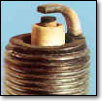 |
Normal Condition without Benefit of Fitch Fuel Catalyst
The Spark plug to the left is what a normal plug should look like. Grayish-tan
to white in color indicates the plug is operating at the proper heat range as
well as correct jetting and the cylinder is running healthy. This plug was
operated on a vehicle without a Fitch Fuel Catalyst.
|
|
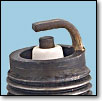 |
Normal Condition with Fitch Fuel Catalyst
This is one of four plugs removed from a 1986 GM Cutlass 2.2l. 85,000 miles
were accumulated on this plug in normal driving with regular octane fuel after
the Fitch Fuel Catalyst was installed. Notice the clean electrodes, absence
of carbon, and like new condition. This is evidence of complete combustion and
that the combustion chamber is clean and like new as well.
|
|
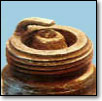 |
Worn Out Condition
Excessive electrode wear, misfire during acceleration and hard starting.
Simply put as in its description, it's worn out ... it looks ok color wise,
so replace it with same plug or at least compatible heat range. You've all
heard the term "If it works, don't fix it". Don't look for flaws with
this plug ... just blame yourself for not changing it sooner.
|
|
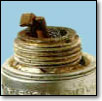 |
Mechanical Damage
Foreign objects in the combustion chamber or an improper plug length may
cause this if it contacts the piston. Even a piece of carbon can do this.
To solve this, make sure you have the correct length tip spark plug as well
as removing any foreign materials in the combustion chamber. In some cases
you may have excessive carbon buildup on the backs of the intake valves
that will have to be addressed.
|
|
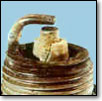 |
Detonation
In cases of severe detonation, insulators may become cracked or chipped.
Improper spark plug gap settings will also cause the insulator tip to
crack or chip. Detonation is tricky... make sure that you are using the
correct octane fuel first and then verify correct ignition timing. Next
check for an inoperative EGR system (if equipped) as well as proper
function of the Knock Sensor (if equipped). Also, you will want to make
sure you are using the correct heat range plug.
|
|
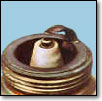 |
Overheated
In this instance you will notice a chalky appearance, white insulator, rapid
electrode wear as well as an absence of deposits. The actual shell may also be discolored.
To cure this you must first verify that the plug is the correct heat
range, the ignition timing settings are correct, the air/fuel mixture is
not too lean, there are no vacuum leaks and that the EGR valve (if equipped)
is functioning properly.
|
|
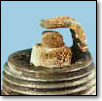 |
Ash Deposits
These are light-brownish deposits that are encrusted to the ground and/or center electrode(s).
Oil and/or fuel additives cause this situation. This condition can cause misfires.
The cure for this is to verify worn valve guides or valve seals, not
using fuel additives, or you might even try changing fuel brands. By
the way, a hotter plug is what most people try to fix this problem. You
need to first understand that the plug is NOT typically the problem.
|
|
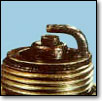 |
Oil Fouled
Oily coating caused by poor oil control. Oil is leaking past worn valve guides,
piston rings, or on some race engines a possible intake gasket leak and then
entering the combustion chamber. Check for worn valve guides, intake
gasket sealing alignment, as well as worn cylinder walls and piston rings.
A leak down test is a good place to start for what is causing this.
|
|
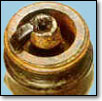 |
Initial Pre-ignition
This will usually look as a melted center electrode and/or ground electrode.
Check for incorrect heat range plug, over-advanced timing, lean fuel mixtures,
inoperative EGR valve or Knock Sensor (if equipped) and also look for hot
spots or deposit accumulation inside the combustion chamber. If you or
your engine builder took the time, all areas of combustion chamber should
have been de-burred to eliminate this problem. This includes the sharp
edges on the chamber, piston top, and cylinder wall valve relieves (if applicable).
|
|
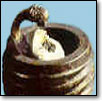 |
Sustained Pre-ignition
This will be pretty obvious ... melted and/or missing center and/or ground
electrodes as well as a destroyed insulator. Check for incorrect heat
range plug, over-advanced timing, lean fuel mixtures, inoperative EGR
valve or Knock Sensor (if equipped) and also look for hot spots or deposit
accumulation inside the combustion chamber. If you or your engine builder
took the time, all areas of combustion chamber should have been de-burred
to eliminate this problem. This includes the sharp edges on the chamber,
piston top, and cylinder wall valve relief's (if applicable).After you
see this, you'd better look for possible internal engine damage as well.
(Pistons, cylinder walls, valves, rings, etc.)
|
|
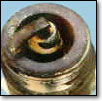 |
Splashed Deposits
These look as if they are small islands of contaminants on the insulator.
This is usually from dirty carburetor bores or air intake as well as the
possibility of a dirty or faulty injector. Using the Fitch Fuel Catalyst
may remove these or you may want to use an aggressive carb and choke cleaner
or other fuel injector cleaner on fuel injected vehicles or injector removal
and cleaning before installing new spark plugs and a Fitch Fuel Catalyst.
|
|
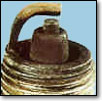 |
Carbon Fouled
This is very common visual condition on race engines. Soft, black, sooty,
dry-looking carbon. This indicates a rich mixture, weak ignition or wrong
heat range plug (too cold). You will first need to verify plug heat range.
On carbureted engines, check choke as well as choke pull-off (if equipped)
for proper function and adjustment. On fuel-injected engines, check for
clogged injectors and the cold-start valve and circuit. You also need to
check for correct fuel pressure settings.
|
On computer-controlled engines, all input signals to the computer need to be working
and accurate. This includes, but is not limited to, O2 sensors, all temperature and
pressure sensors, as well as the EFI system components. Last on all engines, check
for vacuum leaks, poor TPS voltage and weak spark or low voltage output.
|
Call Toll Free for more Information, or to Order.
1-866-GOFITCH
1-866-463-4824Distributed in Canada by PMC Ltd.
Copyright
© 2003 PMC Ltd.
| |





